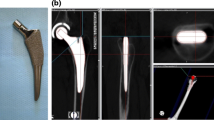Abstract
Background
Whether different body positions during surgery affect postoperative stem alignment in total hip arthroplasty (THA) remains unclear. The purpose of this study was to clarify differences in tapered wedge stem alignment between supine and lateral positions in THA under the modified Watson-Jones anterolateral approach.
Methods
We reviewed 242 consecutive, primary cementless THAs performed with ceramic-on-cross-linked polyethylene via the modified Watson-Jones approach in either supine or lateral positions between 2009 and 2015 (supine group: 113 cases; lateral group: 129 cases). No specific reasons to select supine or lateral positions for the surgery were given during the study period. Computed tomography was performed pre- and postoperatively to measure preoperative femoral anteversion and postoperative stem anteversion, respectively. Stem alignment in coronal and sagittal planes was also evaluated.
Results
Mean difference in stem anteversion and femoral anteversion was 8.6 ± 9.4 in the supine position and 13.0 ± 11.4 in the lateral position (p = 0.0013). Although no significant difference was seen between groups for stem alignment in the coronal plane, flexed implantation was more likely in the supine group (46/113, 40.7%) than in the lateral group (20/129, 15.5%). A significant correlation was found between femoral anteversion and stem anteversion in both the supine and lateral groups (r = 0.68, p < 0.0001 and r = 0.52, p < 0.0001, respectively).
Conclusion
Although stem anteversion was more strongly correlated with femoral anteversion in the supine position than in the lateral position, neutral position in the sagittal plane was more likely to be found with the lateral position than with the supine position. Surgeons can achieve ideal stem positioning by considering these results in the modified Watson-Jones approach in both the supine and lateral positions.





Similar content being viewed by others
References
Dorr LD, Malik A, Dastane M, Wan Z (2009) Combined anteversion technique for total hip arthroplasty. Clin Orthop Relat Res 467(1):119–127
Fessy MH, Putman S, Viste A, Isida R, Ramdane N, Ferreira A et al (2017) What are the risk factors for dislocation in primary total hip arthroplasty? a multicenter case-control study of 128 unstable and 438 stable hips. Orthop Traumatol Surg Res 103(5):663–668
Takada R, Jinno T, Miyatake K, Hirao M, Yagishita K, Yoshii T et al (2019) Supine versus lateral position for accurate positioning of acetabular cup in total hip arthroplasty using the modified Watson-Jones approach: a randomized single-blind controlled trial. Orthop Traumatol Surg Res 105(5):915–922
Reina N, Putman S, Desmarchelier R, Sari Ali E, Chiron P, Ollivier M et al (2017) Can a target zone safer than Lewinnek’s safe zone be defined to prevent instability of total hip arthroplasties? case-control study of 56 dislocated THA and 93 matched controls. Orthop Traumatol Surg Res 103(5):657–661
Sugano N, Nishii T, Miki H, Yoshikawa H, Sato Y, Tamura S (2007) Mid-term results of cementless total hip replacement using a ceramic-on-ceramic bearing with and without computer navigation. J Bone Jt Surg Br 89(4):455–460
Beckmann J, Lüring C, Tingart M, Anders S, Grifka J, Köck FX (2009) Cup positioning in THA: current status and pitfalls. a systematic evaluation of the literature. Arch Orthop Trauma Surg 129(7):863–72
Taniguchi N, Jinno T, Koga D, Ochiai S, Okawa A, Haro H (2019) Comparative study of stem anteversion using a cementless tapered wedge stem in dysplastic hips between the posterolateral and anterolateral approaches. Orthop Traumatol Surg Res 105(7):1271–1276
Taniguchi N, Jinno T, Koga D, Hagino T, Okawa A, Haro H (2016) Cementless hip stem anteversion in the dysplastic hip: a comparison of tapered wedge versus metaphyseal filling. Orthop Traumatol Surg Res 32(5):1547–1552
Kawarai Y, Iida S, Nakamura J, Shinada Y, Suzuki C, Ohtori S (2017) Does the surgical approach influence the implant alignment in total hip arthroplasty? comparative study between the direct anterior and the anterolateral approaches in the supine position. Int Orthop 41(12):2487–2493
Abe H, Sakai T, Takao M, Nishii T, Nakamura N, Sugano N (2015) Difference in stem alignment between the direct anterior approach and the posterolateral approach in total hip arthroplasty. J Arthroplast 30(10):1761–1766
Yoshitani J (2018) The effect of flexion alignment in total hip arthroplasty with a cementless tapered-wedge femoral stem. Eur J Orthop Surg Traumatol 28(8):1625–1632
Takada R, Jinno T, Miyatake K, Hirao M, Kimura A, Koga D et al (2018) Direct anterior versus anterolateral approach in one-stage supine total hip arthroplasty. focused on nerve injury: a prospective, randomized, controlled trial. J Orthop Sci 23(5):783–787
Kishimura Y, Minoda Y, Mizokawa S, Sugama R, Ohta Y, Nakamura H (2019) Cup alignment in total hip arthroplasty using the muscle-sparing modified Watson-Jones approach-comparison between lateral and supine positions. Int Orthop 43(11):2477–2483
Bertin KC, Röttinger H (2004) Anterolateral mini-incision hip replacement surgery: a modified Watson-Jones approach. Clin Orthop Relat Res 429:248–255
Takada R, Jinno T, Miyatake K, Hirao M, Yoshii T, Okawa A (2020) Incidence of tensor fascia lata muscle atrophy after using the modified Watson-Jones anterolateral approach in total hip arthroplasty. Eur J Orthop Surg Traumatol 31(3):533–540
Lee YK, Kim JW, Kim TY, Ha YC, Koo KH (2018) Validity of the intra-operative measurement of stem anteversion and factors for the erroneous estimation in cementless total hip arthroplasty using postero-lateral approach. Orthop Traumatol Surg Res 104(3):341–346
Author information
Authors and Affiliations
Corresponding author
Ethics declarations
Conflict of interest
All authors declare that they do not have any conflict of interest.
Additional information
Publisher's Note
Springer Nature remains neutral with regard to jurisdictional claims in published maps and institutional affiliations.
Rights and permissions
About this article
Cite this article
Takada, R., Jinno, T., Miyatake, K. et al. Difference in tapered wedge stem alignment between supine and lateral position in cementless total hip arthroplasty via modified Watson-Jones anterolateral approach. Eur J Orthop Surg Traumatol 32, 497–503 (2022). https://doi.org/10.1007/s00590-021-03001-4
Received:
Accepted:
Published:
Issue Date:
DOI: https://doi.org/10.1007/s00590-021-03001-4




